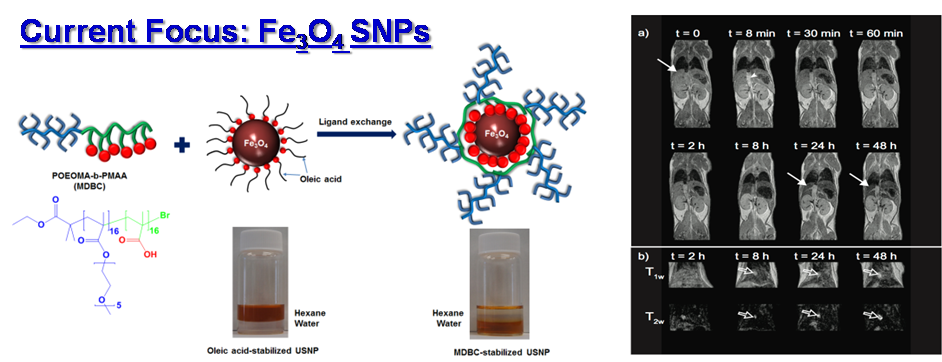RESEARCH
Research stream III: MDBC/hybrids
Polymers possessing multiple anchoring groups capable of multiple binding interactions with metal and solid surfaces have been designed as effective multidentate ligands. Particularly, well-defined multidentate block copolymer (MDBC) can be designed with one anchoring block enabling to bind to surfaces, Compared with small molecules and oligomers having one or two anchoring groups (mono- and bidentate ligands), the MDBC strategy provides stronger binding isotherms due to more favourable conformational arrangements of multiple anchoring groups tethered from long polymeric chains onto metal surfaces.
As an our initial thrust, we have synthesized novel MDBCs with pendant carboxylates and catechol groups bound to superparamagnetic iron oxide nanoparticles (SNPs) for magnetic resonance imaging (MRI). Conventional and biphasic ligand exchange processes and recently in situ (one-pot) method have been explored to fabricate aqueous colloidal SNPs stabilized with MDBCs in single layers. This MDBC coating yielded small MSBC/SNP colloids (hydrodynamic diameter <20 nm) with excellent colloidal stability under physiological conditions, as well as magnetic resonance imaging contract enhancement in vitro and in vivo (animal models).
Given our successful efforts with SNPs, we have further expanded our scope towards other organic and inorganic nanostructures. Supported by FQRNT, our group is developing novel block copolymers to fabricate colloidally-stable water-dispersible quantum dots for bio-imaging and carbon materials such as nanotube and graphene for use as catalyst supports in fuel cells.



